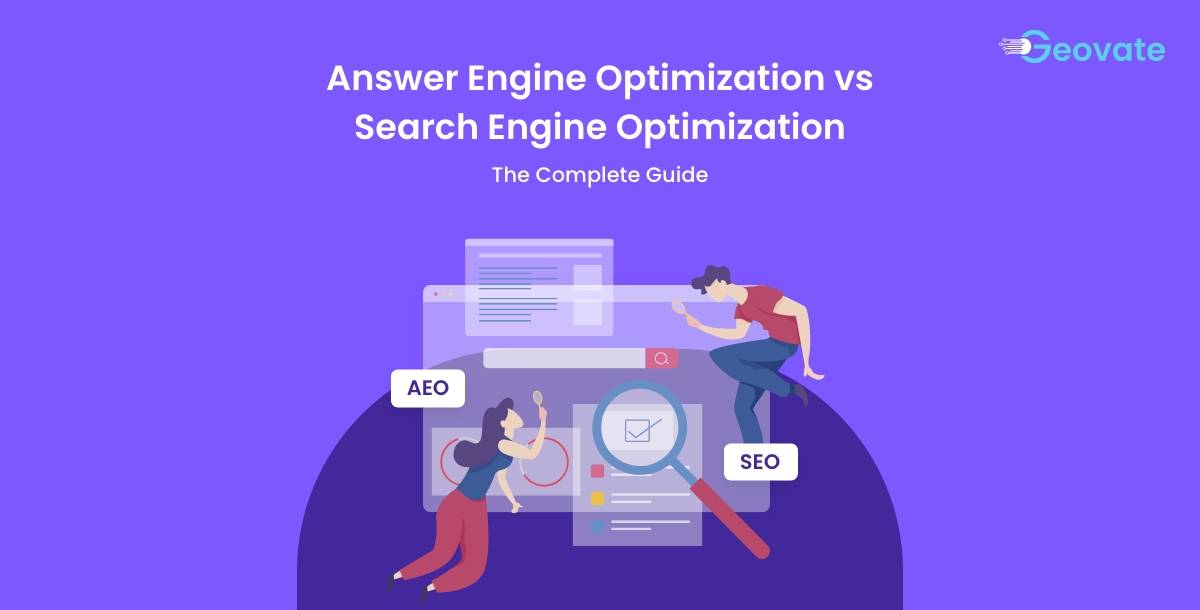AEO vs SEO: The Complete Guide to Answer Engine Optimization vs Search Engine Optimization
Thu,07 Aug 2025 15:17:00- Font Size
- Share Content

In a digital era dominated by AI responses, search engine results pages (SERPs) are no longer the only battleground for visibility. With platforms like Google’s AI Overviews, Bing AI, and ChatGPT influencing how users consume information, Answer Engine Optimization (AEO) has emerged as the new frontier—complementing, not replacing, traditional Search Engine Optimization (SEO).
At Geovate, we understand that modern brands need to be discovered before the click even happens. This blog will help you navigate how AEO and SEO work together, when to use each, and how to prepare for the future of search through AEO services, GEO services, and unified content strategies.
Why Traditional SEO Isn’t Enough in 2025
Search has fundamentally changed.
Over 60% of Google searches end without a click, and on mobile, that number spikes to 77%. Why? Because people are getting their answers directly on the search results page—from featured snippets, knowledge panels, and increasingly, AI-generated summaries.
Now imagine your ideal B2B SaaS prospect searches a question about your industry. Instead of scrolling through links, they receive an immediate AI-generated answer from ChatGPT, Perplexity, or Google SGE (Search Generative Experience). If your content isn’t cited in that answer, you’ve already lost the opportunity—even if you rank #1.
What Is Answer Engine Optimization (AEO)?
Answer Engine Optimization is the practice of optimizing content to be directly cited or extracted by answer engines—LLMs (like ChatGPT), voice assistants, and AI-powered SERPs.
Key Objectives of AEO:
- Make your content the answer, not just a link.
- Capture zero-click visibility, where users see your brand even if they don’t click.
- Structure data for AI systems via schema markup and concise, extractable answers.
As a core part of Geovate’s AEO services, we help businesses gain exposure in conversational search and zero-click environments.
AEO vs SEO: Understanding the Key Differences
Aspect SEO AEO
Primary Goal Rank in search results Appear in AI-generated answers
Content Focus Keyword-rich, long-form content Question-based, structured, concise answers
Success Metrics Traffic, rankings, CTR Visibility, brand mentions, AI citations
User Journey Click-through to website Zero-click satisfaction
Technical Focus Site speed, mobile optimization Schema markup, structured data, AI-consumable content
Rather than viewing them as competing strategies, businesses must see SEO and AEO as intertwined disciplines. Answer engine optimization services build on the foundation that SEO lays.
The Rise of Generative Engine Optimization (GEO)
A new evolution of AEO, Generative Engine Optimization (GEO) focuses on optimizing content specifically for generative AI platforms like ChatGPT, Gemini, Claude, and Perplexity.
What Does GEO Do?
- Ensures your brand is cited or referenced in LLM outputs
- Tailors your content structure and tone for AI consumption
- Adapts for voice and multimodal search environments
- Emphasizes structured data and concise summaries
At Geovate, we incorporate Generative Engine Optimization services into our broader digital strategy frameworks, helping brands show up in every AI-powered touchpoint.
Core Pillars of AEO
- Featured Snippets Optimization
- Aim for “position zero” with precise answers of 40–60 words.
- Use H2/H3 headings that mirror real user questions.
- Schema Markup
- Implement FAQPage, HowTo, Product, and LocalBusiness schemas.
- This structured data makes your content readable and extractable by AI.
- Zero-Click Strategy
- Focus on visibility, not just clicks.
- Track brand impressions, featured snippet share, and answer engine mentions.
- Voice Search Readiness
- Write content in conversational tones.
- Use long-tail, natural language queries that mimic real speech.
SEO Still Matters—Here’s Why
Even as answer engines rise, SEO is the foundation. Without high organic rankings, AI platforms may never find your content to cite.
In fact, studies show:
“76% of AI-generated citations come from the Top 10 organic results.”
Core SEO Components Still Relevant in 2025:
- On-Page SEO: Title tags, meta descriptions, keyword optimization
- Off-Page SEO: Link building, brand mentions, authority signals
- Technical SEO: Mobile-first design, site speed, crawlability
Think of SEO as the infrastructure and AEO as the packaging that makes content AI-friendly.
Unified Strategy: How to Blend AEO + SEO Effectively
The smartest brands are no longer asking “AEO vs SEO?”—they’re asking how to integrate both.
1. Hub-and-Spoke Model
- Hub Pages: In-depth guides that establish topical authority (SEO)
- Spoke Pages: Specific question-answer pages optimized for AEO
- Link them together to build context and semantic relationships.
2. Smart Content Structuring
- Begin content with a 40-60 word summary that answers the main question.
- Use natural headings (e.g., "What is answer engine optimization?").
- Keep paragraphs short and punchy—AI likes clarity.
3. Dual Technical Optimization
- Use schema markup for AI, but don’t neglect SEO essentials like XML sitemaps, robots.txt, and canonical tags.
- Maintain fast load speeds, secure hosting (HTTPS), and mobile responsiveness.
4. Track Both Sets of Metrics
- SEO Metrics: Organic traffic, keyword rankings, backlinks, CTR.
- AEO Metrics: Featured snippet tracking, AI citation frequency, zero-click impression share.
Industry Applications: Who Benefits the Most?
B2B SaaS
- Use AEO to win in early consideration (TOFU) stages.
- Create comparison content and "vs" pages.
- Keep SEO strong for product pages and technical documentation.
E-commerce
- AEO shines in product specs, comparison charts, and shopping queries.
- Use schema to ensure AI references your products.
Local Businesses
- Prioritize voice search optimization and LocalBusiness schema.
- Appear in map packs and conversational queries (e.g., “best plumber near me”).
Healthcare & Finance
- AEO must be handled carefully with disclaimers and accuracy.
- Use authoritative citations and schema for trustworthiness.
The Future of Search: Multimodal & Personalized
What’s Coming Next?
- Multimodal Search: Users will input voice, images, and text in a single query.
- AI API Integrations: Brands may submit structured data directly to AI engines.
- Personalized AI Results: Search results will depend on user behavior, preferences, and device usage.
How to Prepare
- Invest in structured content libraries.
- Prioritize schema implementation as a default—not an afterthought.
- Monitor AI exposure, not just web traffic.
Why Geovate?
At Geovate, we help B2B SaaS companies, local businesses, and e-commerce brands optimize for the AI age of search. Our tailored AEO services and GEO services position your business not just to be found—but to be trusted and cited by the most influential AI platforms on the web.
We:
- Build schema-rich content frameworks.
- Analyze AI visibility performance.
- Blend traditional SEO with next-gen AEO.
- Implement the hub-and-spoke content system tailored to your industry.
With our answer engine optimization services, your brand gets more than traffic—it gets recognition, authority, and conversions before the click even happens.
Final Thoughts: Stop Chasing Clicks. Start Owning Answers.
2025 isn’t about choosing between AEO and SEO. It’s about adopting a search strategy that works in a zero-click, AI-mediated world.
Your content needs to:
- Be found by humans (SEO)
- Be cited by AI (AEO)
- Be structured for both (GEO)
Start today with a single AEO-optimized page. Monitor your brand mentions across AI answers. Invest in visibility, not just vanity metrics.
Let Geovate guide you into the future of search—with answer engine optimization services that transform your digital presence from clickable to unmissable.
FAQs
Q1: Is AEO replacing SEO?
No. AEO builds upon SEO. High-ranking pages are more likely to be cited by AI systems. It's a complementary relationship, not a replacement.
Q2: What’s the role of generative engine optimization?
GEO ensures your content is consumable and cited by generative AI platforms like ChatGPT, Gemini, and Bing AI. It combines AEO principles with generative search capabilities.
Q3: How do I get started with AEO?
Start by implementing the FAQPage schema, rewriting key content into Q&A formats, and creating concise summaries for every article. Partnering with an agency like Geovate can streamline this process.
Q4: Can I use the same content for both SEO and AEO?
Yes, but it requires strategic structuring. Long-form content optimized for SEO can include AEO-friendly elements like concise summaries, Q&A sections, and schema markup. The key is to make the content both comprehensive for human readers and scannable for AI engines. Using a hub-and-spoke content model allows you to satisfy both goals within the same ecosystem.
Q5: How long does it take to see results from AEO and GEO services?
While traditional SEO may take 3–6 months to show ranking improvements, AEO and generative engine optimization (GEO) can yield visibility gains in AI-generated answers much faster—sometimes within weeks—depending on content quality and domain authority. However, long-term success requires continuous monitoring, structured data implementation, and updates aligned with evolving AI models. Partnering with specialists like Geovate accelerates this process through proven frameworks and reporting.
